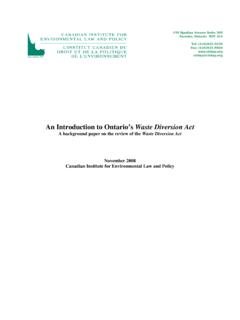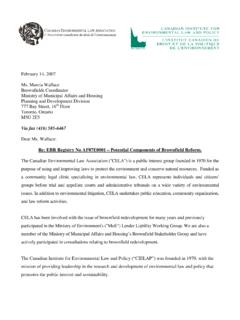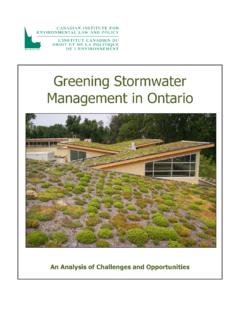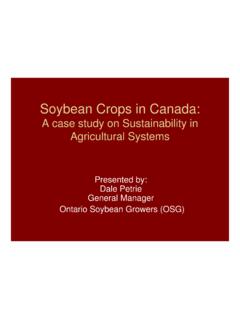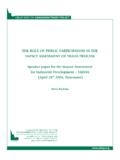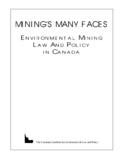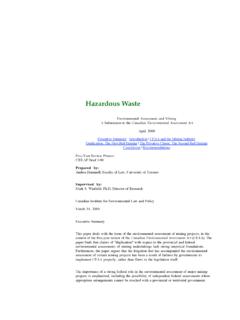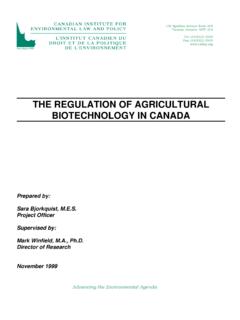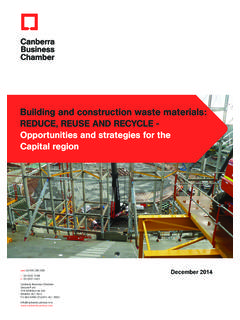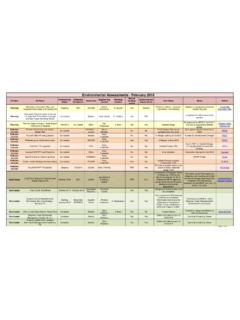Transcription of HAZARDOUS WASTE MANAGEMENT IN ONTARIO: A …
1 HAZARDOUS WASTE MANAGEMENT IN ontario : a report and recommendations . Prepared by: Mark S. Winfield, Director of Research Canadian Institute for Environmental Law and Policy February 1998. Copyright 1998 Canadian Institute for Environmental Law and Policy. All rights reserved. No part of this publication may be reproduced, stored in a retrieval system, or transmitted, in any form or by any means, photocopying, electronic, mechanical, recording or otherwise without prior written permission of the copyright holder. Printed in Canada on recycled paper at a unionized printer. Acknowledgements The Canadian Institute for Environmental Law and Policy would like to extend its appreciation to the funders of this project: the Laidlaw Foundation, the Helen McRae Peacock Foundation and the Richard Ivey Foundation. Thanks, as well, are extended to officials and staff at the ontario Ministry of the Environment, Environment Canada, Metro Works Department of the former Municipality of Metropolitan Toronto, the Association of Municipal Recycling Coordinators, Safety-Kleen Canada Ltd, the Environmental Law Institute ( ) and others who provided information and answered many questions.
2 The Institute would also like to thank those who contributed to the research, writing, editing or production of this document: Jan Rabantek, Abdul Majid Qazi, Sara Bjorkquist, Greg Jenish, Geoff Ruby, Trevor Fleck and Carolyn Cosco. Finally, it is the policy of the Canadian Institute for Environmental Law and Policy that its reports are peer reviewed by experts in the field. The Institute would like to thank the peer reviewers of this report for lending their expertise to this project. The views expressed are, however, those of the author, as is responsibility for any errors. For more information about this publication or its publisher contact the: Canadian Institute for Environmental Law and Policy 517 College Street, Suite 400. Toronto, ontario M6G 4A2. telephone (416) 923-3529. facsimile (416) 923-5949. E-mail: ISBN 1-896588-24-7.
3 HAZARDOUS WASTE MANAGEMENT IN ontario : a report and recommendations . Table of Contents I. INTRODUCTION. II. HAZARDOUS WASTE MANAGEMENT IN. ontario : AN INTRODUCTORY OVERVIEW. III. THE LEGAL, REGULATORY AND POLICY. FRAMEWORK FOR HAZARDOUS WASTE . MANAGEMENT IN ontario . IV. INDUSTRIAL, COMMERCIAL AND. INSTITUTIONAL SECTOR HAZARDOUS . WASTE MANAGEMENT IN ontario . V. POLYCHLORINATED BIPHENOLS (PCB'S). VI. WASTE PESTICIDES. VII. BIOMEDICAL WASTES. VIII. WASTE OIL. IX. HOUSEHOLD HAZARDOUS WASTES. X. SUMMARY AND CONCLUSIONS. LIST OF ACRONYMS. APPENDIX A : CONSOLIDATED recommendations . EXECUTIVE SUMMARY. This project set out to assemble as complete a picture as possible of the MANAGEMENT of HAZARDOUS WASTE , including other forms of 'subject' WASTE , in ontario , from publicly available or accessible information sources. The project has its origins in the debates which occurred in the aftermath of the ontario Environmental Assessment Board's November 1994 decision against the ontario WASTE MANAGEMENT Corporation's (OWMC).
4 Proposed comprehensive HAZARDOUS WASTE treatment and disposal facility. The Ministry of the Environment's proposals for major revisions to the province's regulatory framework for HAZARDOUS WASTE MANAGEMENT in July 1996 further highlighted the need for a study of this nature. The review examines the generation, sources, composition and fate of the overall HAZARDOUS WASTE stream from industrial, commercial and institutional sources, and a number of specific WASTE streams which are sufficiently distinct to warrant individual attention. These include PCB's, WASTE Pesticides, Biomedical Wastes, WASTE Oil and Household HAZARDOUS Wastes. The report identifies significant gaps in the available information, and underlying regulatory framework for the protection of public safety, public health and the environment, regarding the generation, handling and fate of HAZARDOUS wastes in ontario .
5 It also concludes that the recent proposals for changes to the regulatory framework made by the provincial government seem likely to widen, rather than narrow these gaps. In some cases, it suggests that their implementation could pose significant risks to public safety and environmental quality. The report also highlights the degree to which the province of ontario is falling behind other jurisdictions in this area, particularly in terms of information gathering and public reporting, and the promotion of pollution prevention through HAZARDOUS WASTE reduction. The report notes that other jurisdictions have established producer responsibility requirements regarding household HAZARDOUS wastes, integrated their WASTE generation, transfer and release reporting systems with pollution prevention planning requirements, and applied charges or taxes on HAZARDOUS WASTE generators to promote WASTE reduction.
6 Consequently, the report makes comprehensive recommendations for the overhaul and modernization of the province's reporting and regulatory regime for the MANAGEMENT of HAZARDOUS and other forms of 'subject' WASTE . These steps are regarded as being necessary to provide an adequate information base for public policy decision-making, ensure the accountability of industry and government, protect the public's safety, health and environment, and promote pollution prevention and HAZARDOUS WASTE reduction. recommendations are also made regarding the federal reporting and regulatory regime affecting the MANAGEMENT of HAZARDOUS wastes in ontario , particularly with respect to the National Pollutant Release Inventory, and the regulation of interprovincial and international movements of HAZARDOUS wastes. I. INTRODUCTION. This project has its origins in the outcome of the environmental assessment of the ontario WASTE MANAGEMENT Corporation's (OWMC) proposed HAZARDOUS WASTE treatment and disposal facility.
7 In November 1994, the Environmental Assessment Board accepted the need for additional HAZARDOUS WASTE treatment and disposal capacity in ontario , but 1. rejected the Corporation's proposed facility on technical grounds. The provincial cabinet rejected an appeal of the Board's decision by the OWMC in February 1995. The results of the OWMC experience, which had begun with the creation of the Corporation in 1980, highlighted the confusion and lack of comprehensive and reliable information about the MANAGEMENT of HAZARDOUS wastes in the province of ontario . This problem was further emphasized in a 1995 Organization for Economic Cooperation and Development (OECD) study on environmental protection in Canada. This document reported that Canadian governments had been able to provide the OECD review team with 2. an estimate of the generation of HAZARDOUS WASTE in Canada.
8 The need for an independent and comprehensive review was also emphasized by the Ministry of the Environment and Energy's July 1996 proposals for extensive changes to the regulatory regime for the MANAGEMENT of HAZARDOUS These proposals, which were presented with little or no supporting data and information, prompted widespread expressions of concern, as they were seen to be likely to significantly weaken the existing regulatory The situation prompted the Canadian Institute for Environmental Law and Policy (CIELAP) to initiate this study of the MANAGEMENT of HAZARDOUS and other subject' (liquid industrial and registerable solid) wastes in ontario in the fall of 1996. The project sought to achieve three major goals. First, it was to attempt to generate as complete a picture as possible of the current sources, quantities, composition and fate of the estimated - million tonnes of what is classified as HAZARDOUS wastes generated in the province each year.
9 This was to be done using publicly available or accessible sources of information. Secondly, it sought to document and assess the current regulatory and policy regime for the MANAGEMENT of HAZARDOUS wastes in ontario . This effort was focussed, in particular, on the changes that have occurred since the Institute's last review, completed in 1989,5 and on the potential impact of the changes proposed by the province in July 1996. Third, on the basis of these reviews, the project was intended to the identify gaps in both the available data and existing regulatory regime, and present options to address these gaps. The resulting recommendations are focused on three goals. First, they seek to ensure the comprehensiveness, accuracy and availability of data regarding the generation and fate of HAZARDOUS and other 'subject' wastes in ontario to decision-makers and the public at large.
10 This is essential from the perspective of the public's right to know the quantities, nature and fate of these wastes that are being transported through or generated, processed, treated, or recycled in their communities. The communities that bear the environmental and health risks associated with these activities have a basic right to be informed about them. Public access to this information is also central to the ability of the 2. public to hold governments to account for the consequences of the public policy decisions that they make. In addition, improvements in the available data are necessary in terms of the need for adequate information on which to base rational public policy decisions. Furthermore, Canada is required to inventory its generation of HAZARDOUS wastes under the Basel Convention on the Transboundary Movement of HAZARDOUS Wastes.
